Why You Should Travel to Scotland in Winter
Travelling Scotland in winter is the best time for tranquility. The season is known for its long, dark nights and colder weather but what no one talks about is the unique festive traditions, the Northern Lights, the roaring waterfalls and the snow covered mountains. There’s something truly special about visiting during this period with no tourists. So many travelers flock to Scotland between June and September for peak season making it overcrowded and sometimes overwhelming. In winter you have the place to yourself, just you, the wildlife and the stars.
We know Scotland’s winter isn’t known for its lush weather however in the words of Billy Connolly “There’s no such thing as bad weather, just the wrong clothing”. So zip up your winter jacket and prepare yourself as I share with you 7 reasons why you should visit Scotland in winter and some top tips for when you do.
1. Scotland's Winter Festivals
There is so much to look forward to in Scotland’s winter calendar. It is filled with vibrant festivals and events a lot of which have played a role in Scottish life for centuries. Here are a few examples of the festivals you can look forward to:
- Hogmanay – the Scottish New Year celebration, is one of the world’s most famous. If you watched the Euros you will know if there’s no Scotland there’s no party. So in Scottish style the NY celebration doesn’t just last for one day! In Edinburgh, the Hogmanay celebration kicks off with a Torch Light procession on the 30th December. Signifying the start of the global New Year. Where around 20,000 people light up the city with their torches in what is known as the river of fire. On the 31st Princes Street is closed off for one epic street party including live music, entertainment and DJ sets. All in the lead up to the iconic midnight firework display, Auld Lang Syne and the Ceilidh under the Castle. On New Year’s Day what better way to cure the hangover than the Loony Dook. Where people dress up in creative costumes for charity (or for the pleasure of it) and jump into the icy waters of the Firth of Forth. Believe me, its FREEZING but a whole lot of fun!
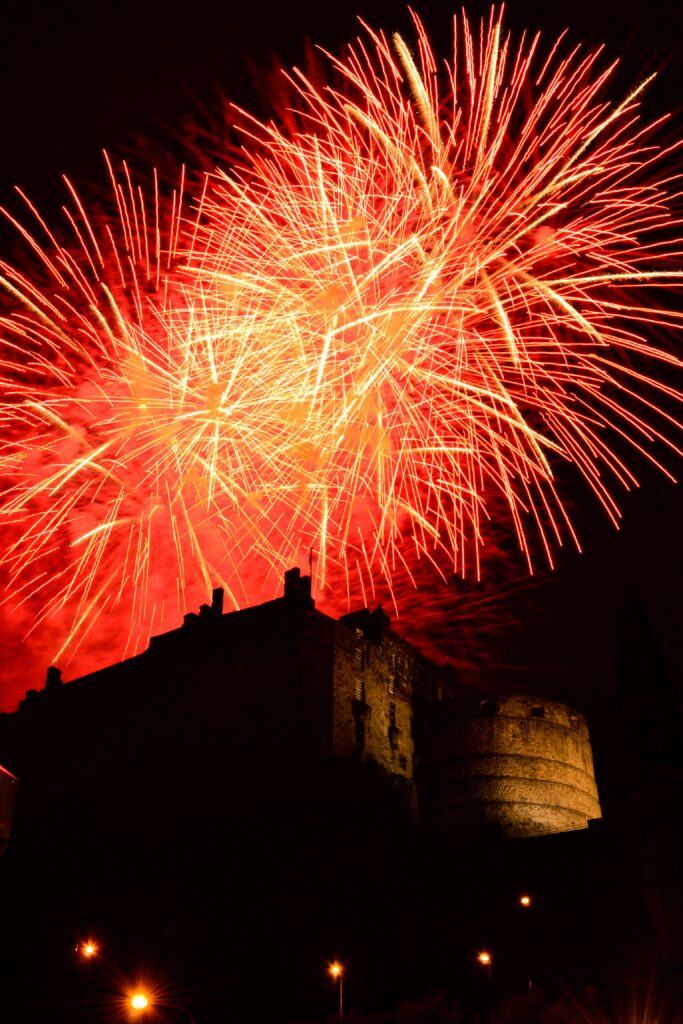
Hogmanay in Edinburgh taken by @flexenchris
- Up Helly Aa – in Scotland we LOVE a fire festival! This is a bucket-list-worthy 19th-century Viking-inspired fire festival held on the last Tuesday of January in Lerwick, Shetland Islands. It is thought to have begun with “tar-barrelling,” where young men rolled burning barrels of tar through Lerwick’s narrow streets. This was banned in 1874 due to the danger and damage of local properties but continued through rowdy festive celebrations to the nuisance of the local authorities. This procession, and those that followed ultimately became the festival we know today. The full day of proceedings includes a torchlit procession led by the Guizer Jarl which finishes as they throw their torches into the replica Viking longship. As the fire blazes their voices erupt as they sing “The Norseman’s Home”. A sight or memory once experienced will never be forgotten. If you think you have missed out on Up Helly Aa, don’t worry, throughout Shetland in winter there are another 12 Fire Festivals.
- Samhain – is another Fire Festival held at Holyrood Park in Edinburgh on the 31st October. Rather than having Viking roots this is a modern reimagining of an ancient Celtic tradition, celebrating the end of harvest and marking the start of winter. The event centres on the dramatic tale of Summer’s overthrow by Winter, with a powerful standoff between the Summer and Winter Kings. Watching over this conflict is the Cailleach, a Celtic Goddess, or Divine Hag, who determines the Kings’ fates and welcomes in the darker, colder months. Fire remains a central part of the festival, symbolising both protection and transformation as the community moves into winter’s embrace.
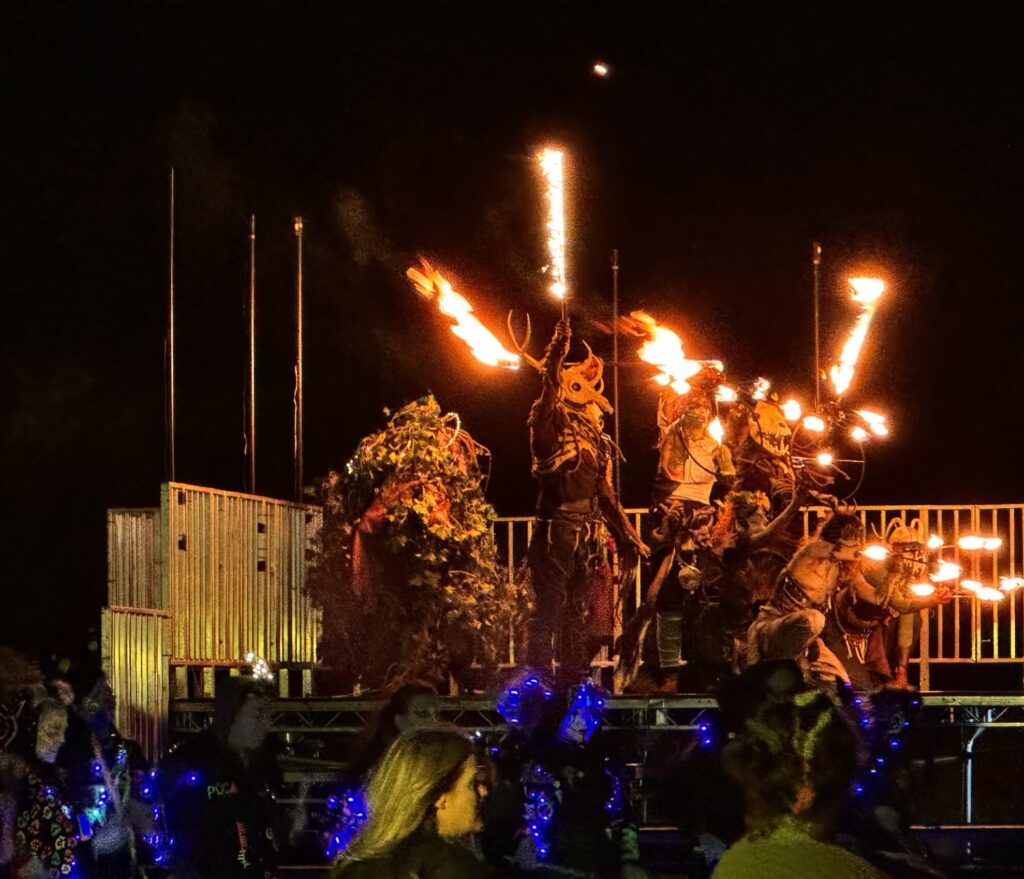
Edinburgh Samhain 2024
- Burns Night – celebrated on 25th January, honours the life and work of Scotland’s national poet, Robert Burns, known for his contributions to Scottish culture and literature. Across the country, people gather at home or at a Burns event to enjoy traditional recitations of his work. Once all guests have arrived, the evening begins with the Selkirk Grace followed by the piping in of the haggis and a passionate recitation of his poem Address to a Haggis. At this point I am sure you know what’s on the menu. Of course, the traditional haggis, neeps, and tatties is served completed with an Immortal Memory toast, honouring Burns’ life and legacy. The meal is topped off with a delicious cranachan or clootie dumpling for dessert. As the night continues with more recitiations of his work. If you want to learn more about Haggis or where to eat it while visiting Edinburgh check out my blog, the Best Haggis in Edinburgh.
- Christmas Markets – the winter season also brings the Christmas markets, ice rinks, mulled wine and festive light displays to cities like Edinburgh and Glasgow. Opening on the 2nd/3rd last Saturday in November adding that much needed festive cheer to the cities of Scotland. Please note that these markets aren’t the size of winter wonderland in London and so during peak hours (especially weekends) there are huge queues so please plan your visit accordingly to avoid frustration.
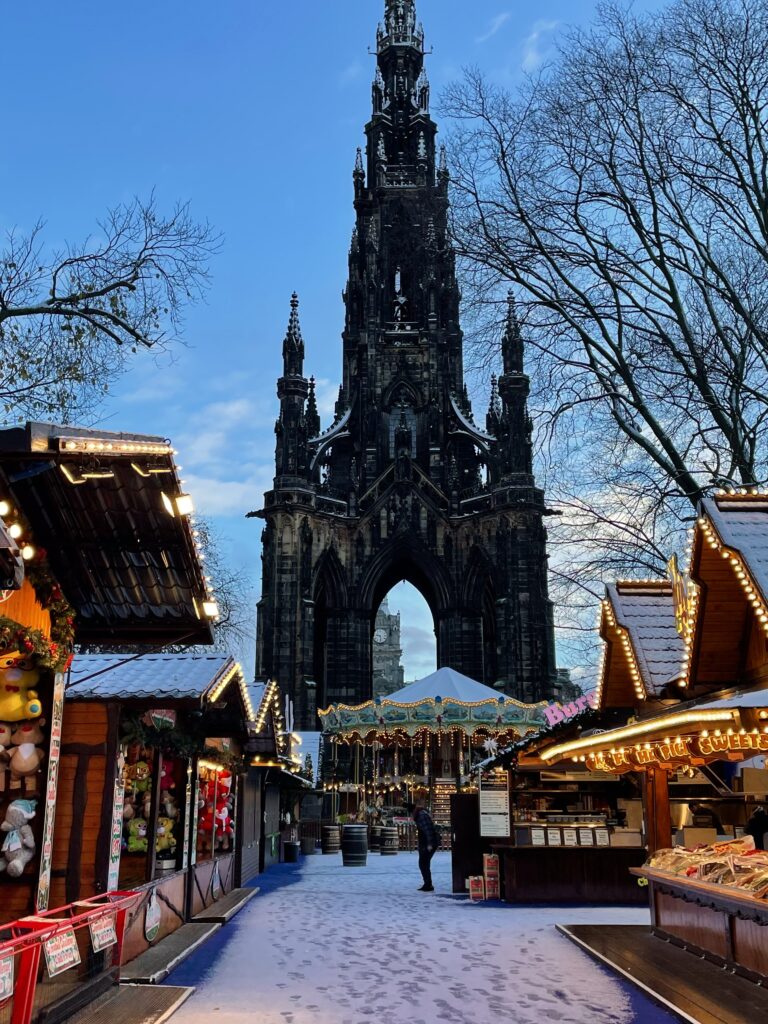
Edinburgh Christmas Markets – a one off snowy day!
2. Breathtaking Winter Landscapes
As autumn takes the leaves from the trees and the weather cools. Scotland’s landscapes take on a magical transformation heading into winter. In the lowlands rainfall increases turning once trickling streams into roaring torrents but in the Highlands we start to see the snow-capped mountains, frosted forests, and mist-covered lochs creating a stunning backdrop for exploration. Areas with higher peaks can be particularly beautiful like Glencoe, the Cairngorms, Lochaber, Torridon and the Isle of Skye, with a layer of snow adding an extra touch of wonder. Winter light also brings out the vibrant tones in the scenery, with low-angled sunlight casting long shadows and highlighting the textures of the land.
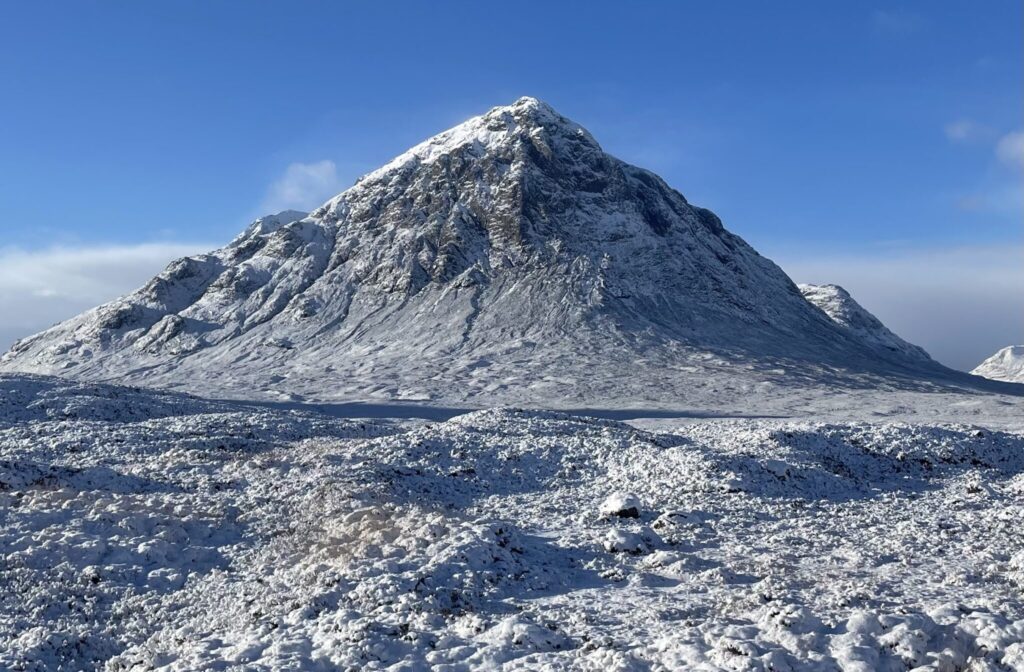
Glencoe in winter
3. Winter in Scotland = More Northern Lights
While the Aurora Borealis is often associated with places like Norway or Iceland, Scotland’s northern regions also offer opportunities to see this natural phenomenon. Especially in 2024 with the sun being at its solar maximum. The further north and more remote you go, the higher your chances of witnessing the Northern Lights. The Orkney and Shetland Islands, along with remote parts of the Highlands, provide ideal conditions. All you need is a clear, dark night with minimal light pollution and some geomagnetic activity to catch a glimpse of this celestial show.
For more information on the Northern Lights and how to see them check out my blog and photos!

4. Less Crowded Attractions
Winter is the off-season for tourism in Scotland, a time when the crowds dwindle, and a peaceful hush finally falls over the landscape. A time when travelling becomes more affordable as accommodation rates fall and have more availability as a whole. For example, imagine the Isle of Skye without the summer bustle. An island with some of the most spectacular landscapes in the world. Without the distractions of crowds, you have the space and time to truly connect with the places you visit. The sense of exclusivity like you’ve stumbled upon something really special.
But on the other side whilst travelling in the peak season. You will find the hotels are either super expensive or sold out, you can be queuing for restaurants, car parking spaces, waiting in traffic on the one way roads and while visiting the Fairy Pools you will be in company of hundreds of people. Is that how you want to experience it? I know I would prefer to spend no time in queues and more time exploring and being spontaneous.
Not only are there fewer people around but the landscapes come alive. Scotland’s wildlife thrives more openly. Winter is a wonderful time to spot red deer coming down from the hills into the glens, drawn closer by the quiet. Along the coast, otters forage undisturbed, and sea eagles soar overhead, scanning the shoreline for food. In this season, nature’s rhythms feel more visible, and each encounter feels special.

5. Winter Sports and Outdoor Activities
The winter season in Scotland unlocks a world of outdoor activities, from skiing and snowboarding to ice climbing and winter hiking. Personally, I tend to steer clear of the slopes as I am literally Bambi on ice. But those that are lovers of these winter sports, this ones for you!
If skiing is on your agenda, I’ve gathered lift and weather report links for each of Scotland’s four major ski centres:
For those interested in winter hiking or ice climbing, especially if you’re new to these activities, I strongly recommend hiring a qualified mountain guide. The Walkhighlands website is a great resource for finding certified guides to help you explore safely.
In addition, the Cairngorms is a uniquely versatile destination. As the only region in Britain with an Arctic and sub-Arctic ecosystem, it’s ideal not only for winter sports but also for observing fascinating wildlife. The Cairngorms is home to Britain’s only free-ranging reindeer herd, with around 150 reindeer roaming freely across the landscape. This year-round attraction offers a rare opportunity to witness these majestic animals thriving in their natural habitat. If you’re visiting on Christmas Day, though, don’t be surprised if they’ve snuck off to help Santa deliver his presents!
6. Cosy Accommodation, Pubs and Winter Warmers
Shattered after a long day exploring or smashing winter sports in section 5? Then there’s nothing quite like escaping the cold outdoors and retreating to a warm, cosy setting. Scotland is home to charming accommodation options such as log cabins, country inns, and historic castles. Or if you don’t want to head home and want to continue the party whether its in the city or a local village you are bound to be nearby a cosy Scottish pub. Many establishments offer roaring fireplaces, traditional Scottish cuisine, and a welcoming atmosphere that’s perfect for unwinding after a day of exploration. You can also indulge in winter warmers like a mulled wine, dram of Scotch whisky, a hot toddy, or traditional hearty dishes like Cullen Skink.
7. Photographic Opportunities
Winter is the perfect time for photography in Scotland. There is no need to use photoshop or AI to remove people from your shots because there’s hardly anyone here! The shorter days mean extended golden hours, giving you fantastic light for capturing the beauty of Scotland’s landscapes. The low-angled winter sunlight enhances textures, making the scenery even more striking and ideal for photographers.
You don’t even have to wake at dawn or stay out until late for the best shots. In summer, sunrise can be as early as 4:30 a.m. and sunset as late as 10:30 p.m. a challenging schedule! In winter, Scotland’s later sunrises and earlier sunsets let you keep your circadian rhythm intact.
Imagine capturing snow-covered peaks, frozen waterfalls, or even the enchanting glow of the Northern Lights. Even Scotland’s historic towns and cities look different in winter, with frost-covered streets and atmospheric lighting adding extra charm to your shots.
And as mentioned earlier, wildlife is more active in the colder months. You might even get a non-paying model or two (deer, birds, or even otters) who seem to be posing just for your camera!
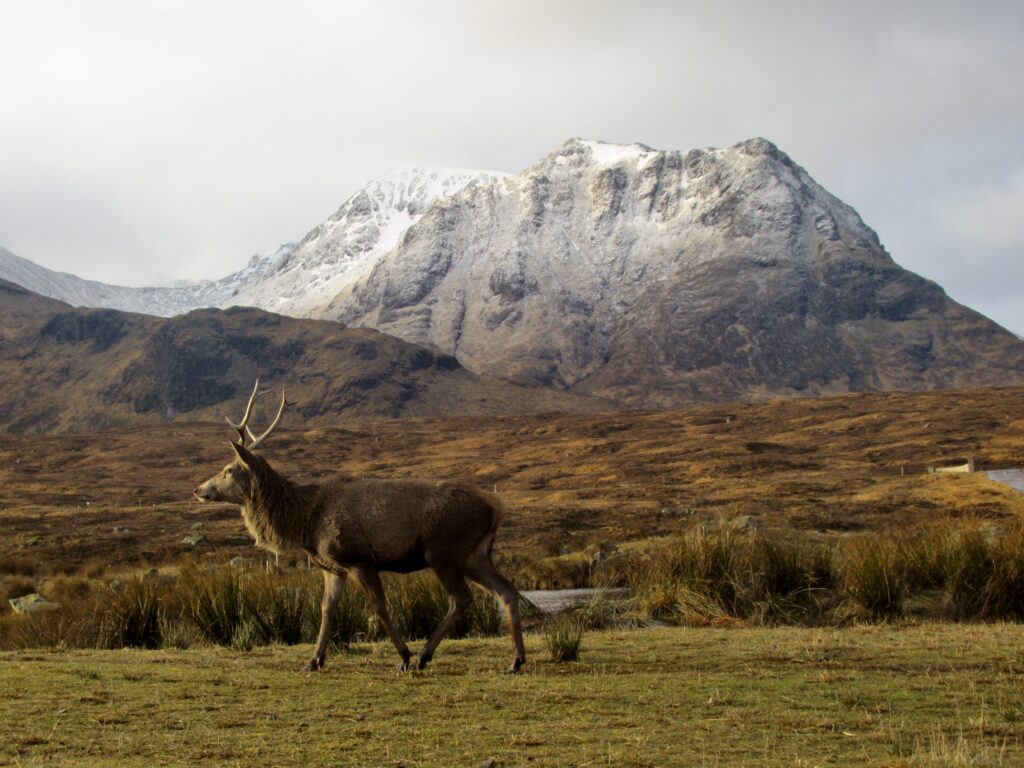
Red Deer in Glen Coe
Practical Tips for Winter Travel in Scotland
- Pack Warm Clothing: Layers are essential, as temperatures can drop, especially in the Highlands and islands. Don’t forget a good quality waterproof jacket and sturdy footwear.
- Check Road Conditions and drive safely: If you plan to drive, be prepared for potential flooding, snow and ice, particularly on rural roads. Check weather forecasts and road conditions in advance as well as the status of the brilliantly named local gritters to see if they are ploughing the road.
- Book Accommodation Early: While winter is the off-season, cosy and unique accommodation like remote lodges can still get booked up quickly. Because some close during the winter giving less choice.
- Be Prepared for Limited Services: In some remote areas, services may be limited or close early in winter. Some tourist attractions including castles and restaurants operate on reduced hours, especially in the Highlands and islands. Booking in advance is a good idea, and bring supplies for any remote excursions.
- Shorter Days and Earlier Sunsets: Winter days in Scotland are short, with the sun setting as early as 3:30 p.m. in December. Plan your activities to make the most of daylight hours and be mindful if you’re travelling in remote areas; ensure you can return safely before dark or bring torches for added safety.
- Hike Safely with Expert Guidance: Winter hiking in Scotland is exhilarating, but conditions can become dangerous, especially for inexperienced mountaineers. Snow, ice, and rapidly changing weather can make trails treacherous. If you’re not experienced with winter hiking or mountain navigation, consider hiring a qualified guide who can ensure a safe and enjoyable adventure.
- Unreliable Public Transport: If you’re heading to Scotland’s islands, ferries offer an affordable way to travel. But winter sea conditions can be rough, which sometimes leads to cancellations or delays, particularly on routes to islands like the Outer Hebrides, Orkney, and Shetland. Stay updated on ferry conditions and consider booking flexible accommodation on the islands in case of delays.
Practical Tips for Winter Travel in Scotland
Thank you for taking the time to read my blog on Why You Should Travel Scotland in Winter. I hope this helps you to understand the benefits that the country has to offer from quieter landscapes to wonderful traditions and festivals to cosy pubs and mulled whisky.
If you’re eager to learn more about Scotland’s history, landscapes, and traditions, be sure to stay tuned for upcoming blogs—or better yet, join us for a winter adventure! From Edinburgh to the Highlands and beyond, Scotland awaits you with open arms and wintry wonders. Until then, happy exploring!